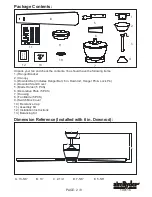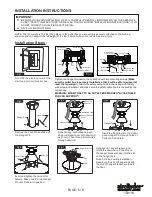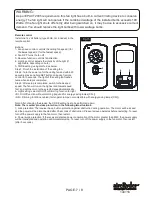
Trouble Shooting Guide
If you have difficulty operating your new ceiling fan, it may be the result of incorrect assembly, installation
or wiring. In some cases, these installation errors may be mistaken for defects. If you experience any faults,
please check this Trouble Shooting Guide. If a problem cannot be remedied or you are experiencing difficulty
in installation, please call our Customer Service Department.
PROBLEM
1. If fan does not start:
2. If fan sounds noisy:
3. If fan wobbles:
4. If light does not work:
1. Check main and branch circuit fuses or circuit breakers.
2. Check line wire connections to fan and switch wire connections in switch
housing.
CAUTION: Make sure main power is turned off.
3. Make sure that the wall control is turned "ON".
1. Make sure all screws in motor housing are snug. (not over tightened)
2. Make sure the screws which attach the fan bladeholder to the motor are tight.
3. Make sure wire nut connectors in switch housing are not rattling against each
other or against the interior wall of the switch housing.
CAUTION: Make sure main power is turned off before entering switch housing.
4. If using an optional ceiling fan light kit, check to be sure the screws securing
the glassware are finger tight. Check to be sure light bulb is tight in socket and
not touching glass shade(s). If vibration persists from glass, remove glass and
install a 1/4 in. wide rubber band on glass neck to act as an insulator. Replace
glass and tighten screws against rubber band.
5. Some fan motors are sensitive to signals from Solid State variable speed
controls. DO NOT USE a Solid State variable speed control.
6. Allow "break-in" period of 24 hours. Most noises associated with a new fan will
disappear after this period.
All blades are weighed and grouped by weight. Natural woods vary in density
which could cause the fan to wobble even though all blades are weight-matched.
The following procedures should eliminate most of the wobble. Check for wobble
after each step.
1. Check that all blades are screwed firmly into blade holders.
2. Check that all blade holders are tightened securely to motor.
3. Make sure that canopy and mounting bracket are tightened securely to ceiling
junction box and junction box is mounted firmly to ceiling joist.
4. Most fan wobble problems are caused when blades are not equally level. To
check the blade levels, select a point on the ceiling above the tip of any blade.
Measure the distance from the ceiling to the blade tip, to an accuracy of 1/8
inch. Rotate the blades until the next blade is in the measuring position. Repeat
measurement for each blade. If all blade levels are not equal, you can adjust
blade levels by the following procedure. To adjust a blade tip down, insert a
washer (not supplied) between the blade and blade holder at the screw
closest to the motor. To adjust a blade tip up, insert washer (not supplied)
between the blade and blade holder at the two screws farthest from the motor.
5. If blade wobble is still noticeable, interchanging two adjacent (side by side)
blades can redistribute the weight and possibly result in smoother operation.
1. Check for loose or disconnected wires in fan switch housing.
2. Check for loose or disconnected wires in light kit.
3. Check for faulty light bulbs.
CAUTION: Make sure main power is turned off before entering switch housing.
4. If the fan light shuts off shortly after being switched on, it may be due to excessive
current demand. Turn off power to the fan and replace the light bulbs with lower
wattage bulbs. Turn on power to the fan, using the pull chain, wall switch, or remote
control (whichever is installed on the particular fan).
SUGGESTED REMEDY
PAGE: 8 / 8
140116
F A N C O
F A N C O



























